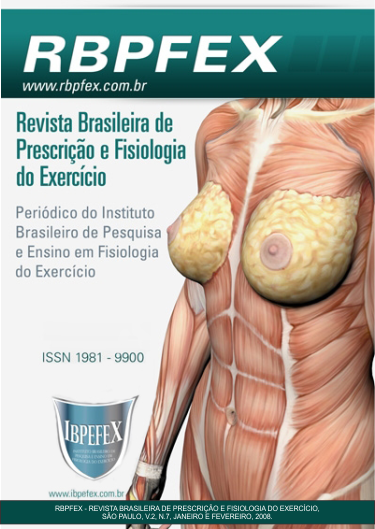Analysis of heart rate of powerlifting’s athletes in competitive situation
Abstract
The objective of this study was to analyze the behavior of Heart Rate (HR) of powerlifting’s athletes in competitive situation and the possible modulation of the HR according to the sex of the athlete, type of exercise performed in the competition, competitive timing (approximation vs. performance) and initial or final attempt to lift the weight. Twenty healthy elite national volunteers athletes (nine men and eleven women), who were taking part at the 23rd Brazilian Powerlifting Championship in 2004 were monitored since the warming up until when the athlete left the competitive platform. The heart rate was monitored on the squat and dead lift exercises by the belt, sensor and the heart rate monitor frequency. The HR was registered only at the first and last attempt, and for the purpose of statistic registration of the dependent variable (HR), the lowest value reckoned in the interval of time between warming up and the execution of the movement and exit of the competitive platform was considered a HR of approximation (AHR) and the highest value was considered the peak of HR (HHR). In general our results show there is no significant difference in the behavior of HC between genders (p = 0.667), attempts (p = 0.567) and exercises (p = 0.741) only the competitive moment showed highly significant differences (p = 0000). It is concluded that there is no significant difference in the behavior of HR between genders, attempts and exercises and that the predominant factor in the modulation of HR is the intensity of muscle movement performed.
References
- Achten, Juul; Jeukendrup, Asker E. Heart Rate Monitoring: Applications and Limitations. Sports Med, p. 517-538, 2003.
- Alonso, Denise de Oliveira; Forjaz, Claudia Lucia de Moraes; Rezende, Liliane Onda; Braga, Ana Maia F.W.; Baretto, Antonio Carlos Pereira; Negrão, Carlos Eduardo; Rondon, Maria Urbana Pinto Brandão. Comportamento da freqüência cardíaca e da sua variabilidade durante as diferentes fases do exercício físico progressivo máximo. Arquivo Brasileiro de Cardiologia, v. 71, n. 06, p. 787-792, 1998.
- Araújo, Cláudio Gil Soares de; Bastos, Mauro Antonio Pinto Machado; Pinto, Nelson Luiz Siqueira; Câmara, Rubens Sampaio. A freqüência cardíaca máxima em nove diferentes protocolos de teste máximo. Revista Brasileira Ciências do Esporte, p. 22, 1980.
- Brum, Patrícia Chakur.; Forjaz, Claudia Lucia de Moraes.; Tinucci, Tais.; Negrão, Carlos Eduardo. Adaptações agudas e crônicas do exercício físico no sistema cardiovascular. Revista Paulista Educação Física, São Paulo, v. 18, p. 21-31, ago. 2004.
- Costa, Denílson. Levantamento de Peso Básico e Lesões. Disponível em: http://www.portaldoferro.com/artlevbas3.htm Acesso em 19 de janeiro de 2008.
- Delavier, Frederic. Guia dos Movimentos de Musculação. Brochura, 2006.
- Haennel, R.G.; Snydmiller, G.D. ; Teo, K.K.; Greenwood P.V.; Quinney, Há.; Kappagoda Ct. Changes in blood pressure and cardiac output during maximal isokinetic exercise. Arch Phys Med Rehabil, v. 73, p. 150-55, 1992.
- Leite, Tiago Costa; Farinatti, Paulo de Tarso Veras. Estudo da freqüência cardíaca, pressão arterial e duplo-produto em exercícios resistidos diversos para grupamentos musculares semelhantes. Revista Brasileira de Fisiologia do Exercício v. 02, p. 29-49.
- Malfatti, C.A.; Rodrigues, S.Y.; Takahashi, A.C.M.; Silva, E.; Menegon, F.A.; Marttinello-Rosa, S.M.; Catai, A.M. Análise da resposta da freqüência cardíaca durante a realização de exercício isocinético excêntrico de grupamento extensor de joelho. Revista Brasileira de Fisioterapia, v. 10, n. 01, p. 51-57, 2006.
- Mcardle, William D.; Katch, Frank I.; Katch, Victor I. Fisiologia do Exercício: Energia, Nutrição e Desempenho Humano. Rio de Janeiro: Guanabara, 2001.
- Polito, Marcos Doederlein; Farinatti, Paulo de Tarso Veras. Considerações sobre a medida da pressão arterial em exercícios contra-resistência. Revista Brasileira de Medicina do Esporte, v. 09, n. 01, jan. /fev. 2003.
- Silverthorn, Dee Unglaub. Fisiologia Humana: Uma Abordagem Integrada. Barueri: Manole, 2003.
- Tan, B. Manipulation Resistence Training Program Variables To Optinize Maximum. Strength In Man: A Review Journal Of Stere And Condititioning Research. v. 13, p. 289-304, 1999.
Authors who publish in this journal agree to the following terms:
- Authors retain the copyright and grant the journal the right of first publication, with work simultaneously licensed under the Creative Commons Attribution License BY-NC which allows the sharing of the work with acknowledgment of the authorship of the work and initial publication in this journal.
- Authors are authorized to enter into additional contracts separately for non-exclusive distribution of the version of the work published in this journal (eg, publishing in institutional repository or book chapter), with acknowledgment of authorship and initial publication in this journal.
- Authors are allowed and encouraged to post and distribute their work online (eg, in institutional repositories or on their personal page) at any point before or during the editorial process, as this can bring about productive change as well as increase impact and impact. citation of published work (See The Effect of Free Access).






